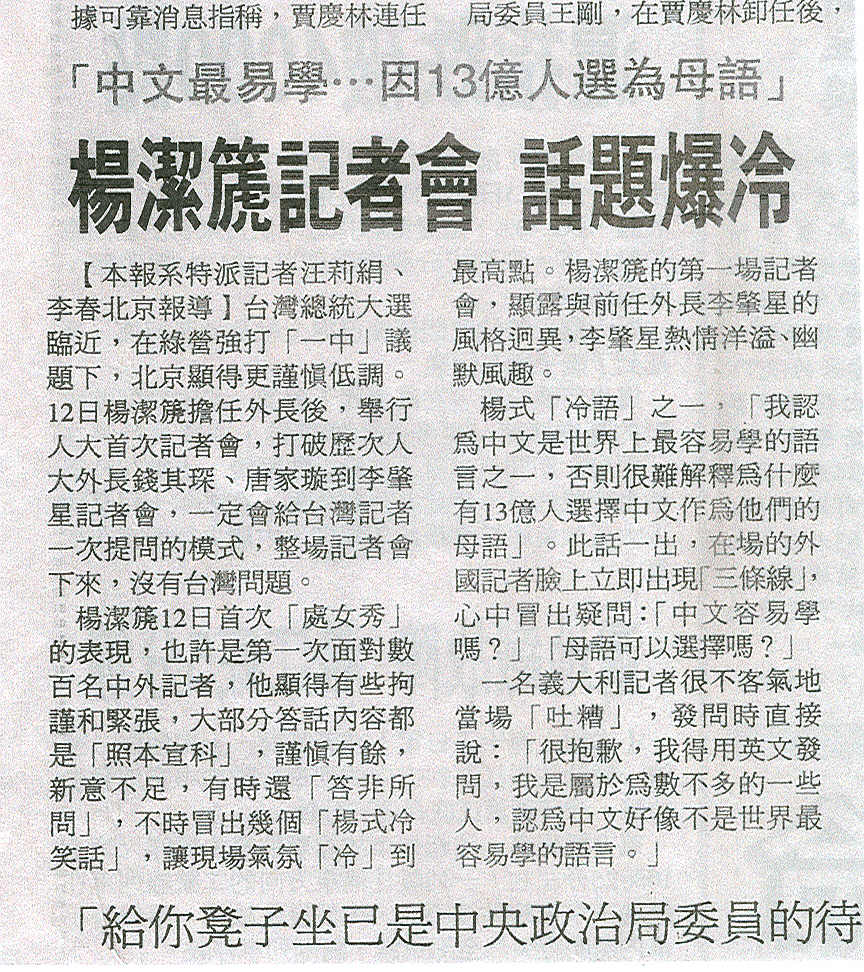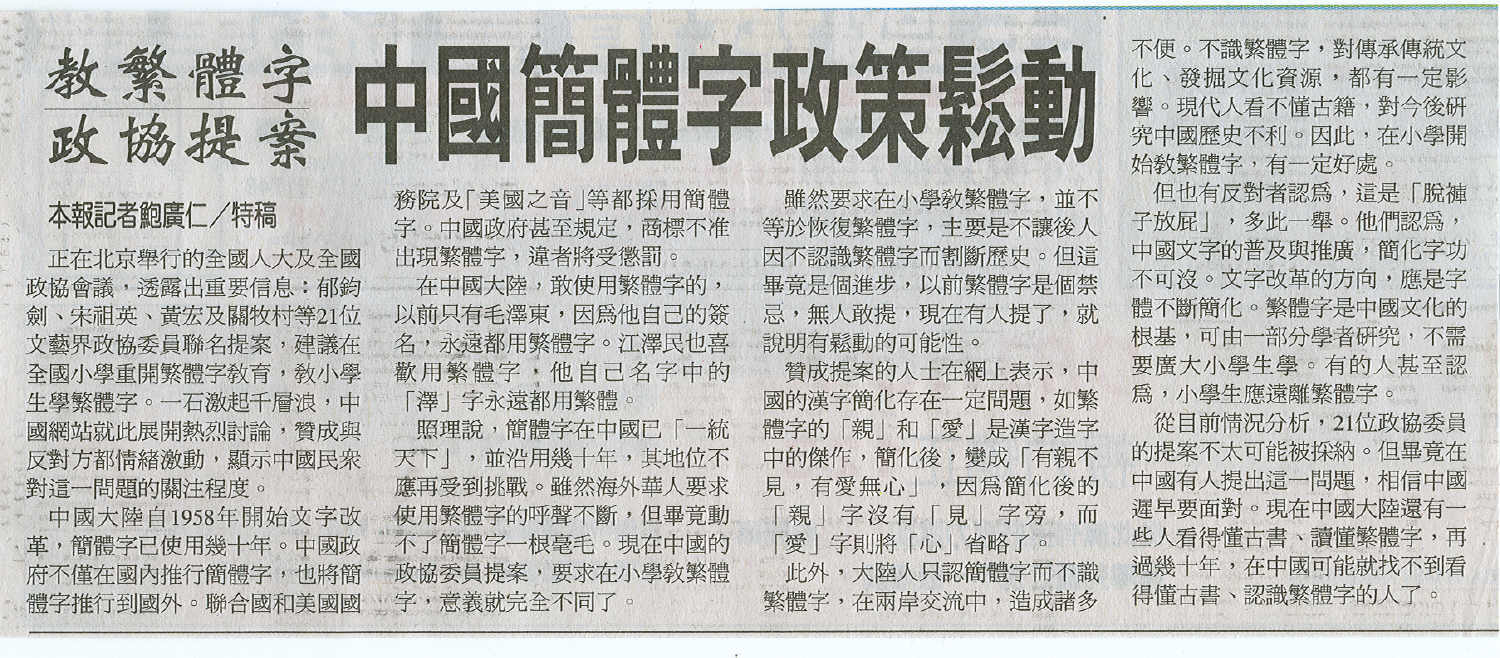On April 23, 2008, Chinese Daily News (1588 Corporate Center Dr., Monterey Park, CA 91754) which is the largest circulated Chinese newspaper in the United States reported the annual conference of Chinese Language Association of USA Secondary-Elementary Schools, which was held in New York with over 700 teachers who teach the Chinese language. The picture below is the report, and it stated three facts:
Every illiterate Chinese can speak very well in Chinese. In fact, the definition of illiteracy is that a person is able to speak well while is unable to read and to write. The current method of teaching Chinese language in the United State is a way to produce illiterates, not literacy in Chinese. For the old way of teaching Chinese language, especially as a second language, there are three damned birth defects.
Because of these birth defects of the Chinese written language, it takes 6 to 7 years for native Chinese to learn three to four thousand words (just being able to read newspaper), 12 to 16 years to learn five to six thousand words (still below a true literacy in terms of Chinese literature, which needs over twelve thousand words). However, if Chinese written language (words) has a chemistry-like logical structure, from atoms to molecule to higher chemical compounds to bio-chemistry to organs to lives, then Chinese written language can be learned just by learning a few atoms and a few bonding rules. As these atoms and rules are few, its entirety can be learned in a few months, perhaps, in three months. As the entire Chinese written language universe is described and encompassed by these few atoms and rules, the entire Chinese written language can be learned in three months. In fact, this is the case; the Chinese written language, indeed, has a chemistry-like logical structure. The following is a brief description on that fact.
In order to master Chinese language as a second language while without living in that language environment, it must be learned as a knowledge, not as a living habit.
There are two major differences between Chinese and English words. Some English words are having root words, such as:
However, the majority of English words are stand alone words, such as, book and love. Although most of them do have an origin of some sort (Latin, Greek, etc.), their meanings cannot be read out loud from their faces.
Thus, the followings are the two major differences between English and Chinese words.
So, love is that hearts hold hands and walk slowly together.
Yet, no one ever learns Chinese written words in this way for the past 5,000 years. Chinese words were always learned as stand-alone words which must be learned one at a time. Of course, for native Chinese, they have a life-time to learn them. Seemingly, this is a great strategy to prevent any foreigner to master Chinese written language before he is Sinicized.
For the past two thousand years, there were only six sentences describing the Chinese Etymology. For the following reasons, they did not provide a foundation for a word root Etymology.
Now, I will give a scientific description of Chinese Etymology here. As ideographs, every Chinese written word can be viewed as a kind of birds. Thus, the following description (the genealogy and the internal dynamics of those birds) can be understood by someone who knows not a single Chinese word. There are four steps to construct the Chinese word system.
Note: The definition of word root here is similar to atom in chemistry, which is the rock bottom building block to build up molecules and the higher structures. Of course, every atom is still having a sub-structure. However, it is a subject of physics, not chemistry. Similarly, these 220 word roots also have substructures which will be discussed in lesson three. Before then, these 220 word roots are viewed as rock bottom units for dissecting Chinese words anatomically and syntactically.
By definition, a module always can be a part of other words. In this book, I have chosen 300 modules which are also sound roots.Note: 部 首 (leading radical) — While word roots and modules are not explicitly described in the ancient Chinese Etymology, the 部 首 (leading radical) is the central pillar of it. In 康 熙 字 典 (dictionary), it lists 214 leading radicals. It consists of two groups:
Obviously, 部 首 alone cannot construct a word root Etymology, as word roots (220) + modules (300) is much larger than leading radicals (214).
Thus, theoretically, every Chinese written word can be as a module.
The entire Chinese written word system is constructed with the above procedure. The following is some examples of the above structure.
Example one:
Example two:
Example three:
Example four:
Example five:
Example six:
With only one example, it can be an incidence. With only two examples, it can still be an coincidence. With more than three examples, it happens as accidence becoming very unlikely. There must be a underlying system driving the phenomena. In fact, the Chinese written word system is almost identical to a chemical compound system.
After May fourth movement of 1919, Chinese scholars unanimously agreed that, being a denotative solitary and non-logical language, Chinese written language was the culprit for China’s demise at that time. For over five thousand years, not only was Chinese government advocated learning as the only pathway to participate in politics but the tradition of countryside also viewed that studying was the only way to a personal prosperity. Yet, by 1950, over 85% of Chinese people were still illiterate because that Chinese written language was too hard to learn even for the native Chinese. Thus, the calling for converting Chinese characters into Roman alphabets was the slogan for China’s culture elite in the 1950s. By 1958, this alphabetizing of Chinese characters was not yet successful. The Chinese government launched simplified Chinese character system as an interim measure to reduce the illiteracy in the country. By 2006, the illiteracy in the country was less than 15%. Thus, the simplification of Chinese characters was viewed as the greatest achievement of Chinese government. In April 2006, Chinese government issued The law of using the Standard (simplified) Chinese Characters in public place, which encompasses all the publications (books and newspaper) and all the street signs. Any way of violating this law is prohibited and will be fined severely.
 In May 2006, Chinese Etymology was published. By only learning 220 root words and 300 sound modules, one can master all (60,000) Chinese characters. The meaning of each and every (100%) Chinese word can be read out loud from its face according to that book. That is, someone who knows not a single Chinese word can master the entire Chinese written language in six months as that course can be easily scheduled as a 200 hour course. After this fact was known, a news report (on November 4, 2007 by Chinese Daily News, P.O. Box 2032, Monterey Park, CA 91754) stated that Chinese government is now contemplating of going back to the traditional Chinese characters. The graph on the left is the copy of that news report.
In May 2006, Chinese Etymology was published. By only learning 220 root words and 300 sound modules, one can master all (60,000) Chinese characters. The meaning of each and every (100%) Chinese word can be read out loud from its face according to that book. That is, someone who knows not a single Chinese word can master the entire Chinese written language in six months as that course can be easily scheduled as a 200 hour course. After this fact was known, a news report (on November 4, 2007 by Chinese Daily News, P.O. Box 2032, Monterey Park, CA 91754) stated that Chinese government is now contemplating of going back to the traditional Chinese characters. The graph on the left is the copy of that news report.
 On March 12, 2008, Chinese Daily News reported a news conference which was hosted by the Foreign Minister of China, and it was the first news conference in his three years in the office. In that news conference, he popped out a strange statement that Chinese written language is one of the easiest language to learn in the world. His statement was immediately rebuked by an Italian reporter. She said, “Minister, I must ask you question in English as I am one of those who is unable to learn that easiest language.” Of course, Minister Yang did not retract his strange statement, and it was reported as a cold joke by all Chinese newspapers. The picture on the left is a copy of that news report.
On March 12, 2008, Chinese Daily News reported a news conference which was hosted by the Foreign Minister of China, and it was the first news conference in his three years in the office. In that news conference, he popped out a strange statement that Chinese written language is one of the easiest language to learn in the world. His statement was immediately rebuked by an Italian reporter. She said, “Minister, I must ask you question in English as I am one of those who is unable to learn that easiest language.” Of course, Minister Yang did not retract his strange statement, and it was reported as a cold joke by all Chinese newspapers. The picture on the left is a copy of that news report.
 On March 15, 2008, Chinese Daily News again reported that one branch of Chinese Parliament (similar to US Senate, composed of from different political parties) initiated a bill for teaching the traditional (not simplified) Chinese character in the grade school (see picture on the left). This is a major reversal for its policy a year ago, and it is an outright putting down China’s greatest achievement, the revolution of Chinese written word system which was attributed as the major force for eradicating the illiteracy in China. That is, this act could be viewed as treason, unless it has become the policy of the government. Seemingly, someone in China has realized that the simplified written language system did not truly simplify it, and Chinese written language can be learned in a much easier manner, in three months.
On March 15, 2008, Chinese Daily News again reported that one branch of Chinese Parliament (similar to US Senate, composed of from different political parties) initiated a bill for teaching the traditional (not simplified) Chinese character in the grade school (see picture on the left). This is a major reversal for its policy a year ago, and it is an outright putting down China’s greatest achievement, the revolution of Chinese written word system which was attributed as the major force for eradicating the illiteracy in China. That is, this act could be viewed as treason, unless it has become the policy of the government. Seemingly, someone in China has realized that the simplified written language system did not truly simplify it, and Chinese written language can be learned in a much easier manner, in three months.
More detailed methodology explanation